![]()
![]()
![]()
Use LEFT and RIGHT arrow keys to navigate between flashcards;
Use UP and DOWN arrow keys to flip the card;
H to show hint;
A reads text to speech;
27 Cards in this Set
- Front
- Back
|
What two type of cells are leukocytes derived from?
|
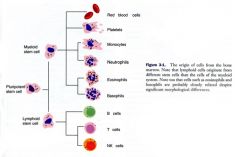
Myeloid (bone marrow) and lymphoid stem cells
|
|
|
What are the different types of leukocytes?
|
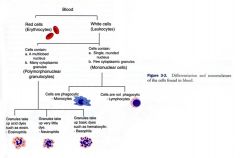
Granulocytes, monocytes and dendritic cells.
Lymphocytes (B cells, T cells, and NK cells) |
|
|
What percent of leukocytes are neutrophils in carnivores? horses? ruminants?
|

60-75% of leukocytes in Carnivores. 50% in horses, and 20-30% in ruminants.
|
|

What do the primary granules of neutrophils contain? What about the secondary granules?
|
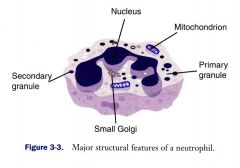
Primary granules: myeloperoxidase, cathepsin B, and elastase
Secondary granules: lysozyme, collagenase, and lactoferase |
|
|
What two kinds of enzymes are involved in slowing down neutrophils for absorption from the bloodstream? Which one slows neutrophils and which one stops them?
|
Selectins and integrins
Selectins slow the neutrophils. The integrins stop them and help them migrate through. |
|
|
What are the enzyme receptor halves on the neutrophil allowing them to bind to endothelial cells?
|

L-selectin and CD11b/CD18
|
|
|
What are the enzyme receptor halves on the endolthelium allowing binding with the neutrophils?
|

P-selectin and ICAM-1
|
|
|
What chemoattractant attracts neutrophils?
|
IL-8
|
|
|
What interleukin triggers transcription of the enzyme responsible for slowing and drawing in the neutrophils from the endothelium?
|
IL-1. In this way, the response can be localized to where the leukocytes are needed.
|
|
|
What are the five steps of neutrophil migration?
|
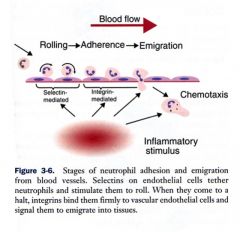
rolling
adherence emigration chemotaxis inflammatory stimulus |
|
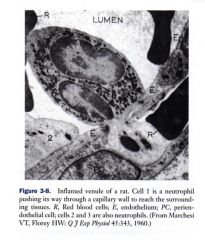
What is this a picture of?
|

A neutrophil emigrating through an endothelium.
|
|
|
During phagocytosis, what are the chemotaxis agents attracting phagocytes?
|
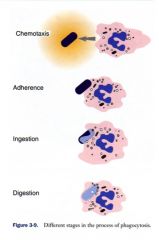
C5a-complement and chemokines (IL-8)
|
|
|
During phagocytosis, what are the agents of adherence? What are their purpose?
|
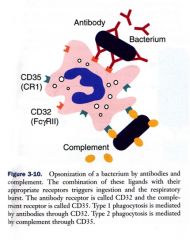
Opsonins (antibodies and complement C3b)
opsonization - make tastier to eat The opsonins entice the neutrophils to phagocytose the bacteria by binding to the bacteria and then binding on the other end to the leukocytes. |
|
|
During phagocytosis, what occurs during the ingestion phase?
|
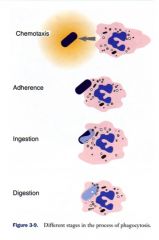
lysosomes (the organelles containing lysozymes) interact with phagosomes (the organelles that contain the phagocytized bacteria) to digest the critter.
|
|
|
During phagocytosis, what occurs during the digestion phase?
|
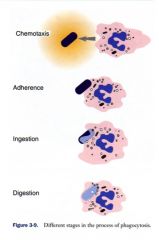
the respiratory burst (where potent oxidants are produced) and then lytic enzymes (with antimicrobial peptides).
The respiratory burst will kill the bacteria, then they will be digested by lytic enzymes. |
|
|
What are the three types of surface receptors of neutrophils?
|

cell adhesion molecules
complement receptors antibody receptors you can see the three receptor types – to bring the leukocytes into the cell (p-selectin, integrin), then the ones that seek out the bacteria. |
|
|
What is the mechanism of the respiratory burst pathway?
|
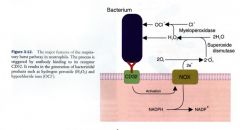
Neutrophils need lots of oxygen to generate oxygen radicals. The consumption of O2 increase 100-fold when stimulated.
So the bacterium binding stimulates NOX, which releases the electrons to make the superoxides which is converted immediately to hydrogen peroxide which is converted quickly to hypochloric acid. |
|
|
which species has less superoxide in the respiratory burst pathway than others?
|
sheep
|
|
|
How doe superoxide dismutase and oxygen radicals cause tissue damage?
How do the neutrophils protect themselves? |
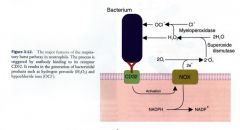
The oxygen radicals and superoxide dismutase are outside of the cells and can cause tissue damage (what happens in arthritis).
The hydrogen peroxide and hypochloric acids can work against the neutrophil as well, but the neutrophil produces lots of glutathione (an antioxidant) to protect it. |
|
|
What are the four antimicrobial molecules?
|
Lytic enzymes (phagolysosomes)
Peptides (defensins) Lysozymes Lectins (selectins, collectins, pentraxins) |
|
|
What is the function of lytic enzymes and lysozymes?
|
To destroy bacterial cell walls.
|
|
|
What are the main antimicrobial molecules? What is their function?
|
Defensins
The kill bacteria, fungi, and viruses |
|
|
What are examples of lectins (antimicrobial molecules)? How do they function?
|
Selectins, collectins (conglutinin and mannose-binding lectin - MBL), and pentraxins (CRPs - c-reactive proteins and SAPs - serum amyloid P)
They act as opsonins and activate complement. |
|
|
What are babies born without MBL susceptible to?
|
The collectins are very important for newborns without an acquired immune system – the MBLs will act as an opsonin. Babies without MBL will be highly susceptible to infection. The lectins are so important because there is no acquired immunity, so the nascent innate immunity of the newborn is extra important
|
|
|
What are examples of pentraxins?
|
Pentraxins are in a ring – CRP (c-reactive protein) and SAP (serum amyloid p) are acute phase proteins.
|
|
|
What are the functions of the primary granules of neutrophils?
|
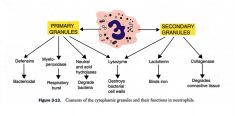
Defensins - respiratory burst
myeloperoxidase - respiratory burst neutral and acid hydrolases - degrade bacteria lysozymes - destroy bacterial cell walls |
|
|
What are the functions of the secondary granules of neutrophils?
|
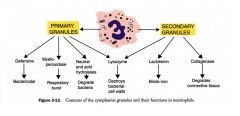
Lysozymes - destroys bacterial cell walls
Lactoferrin - binds the iron that bacteria require, incapacitating them. Collagenase - degrades connective tissue |

